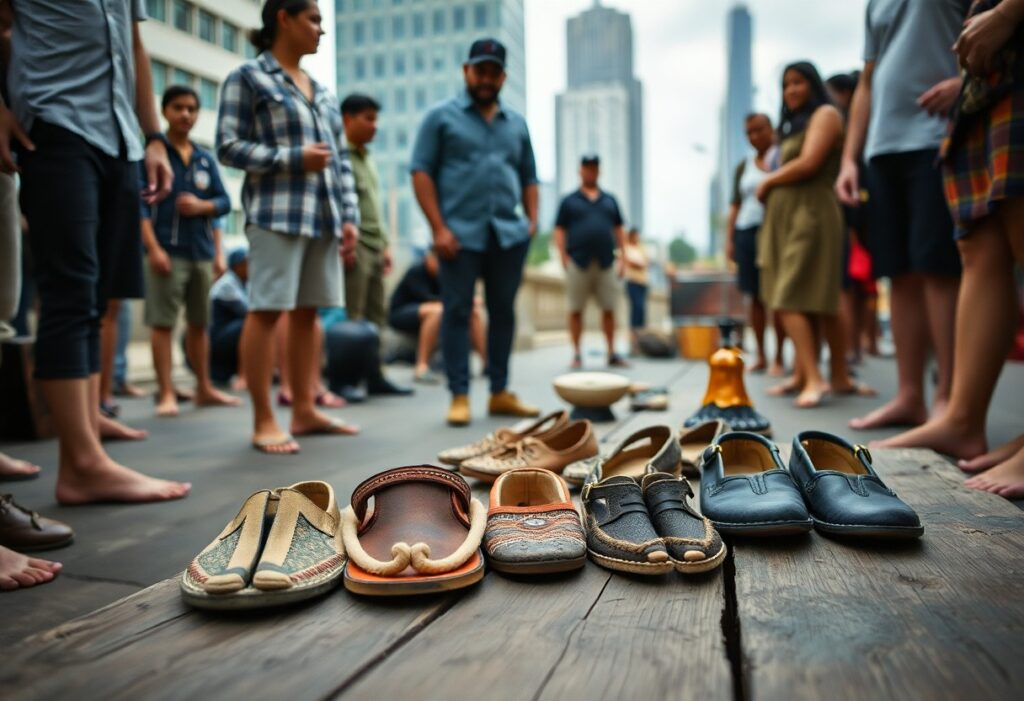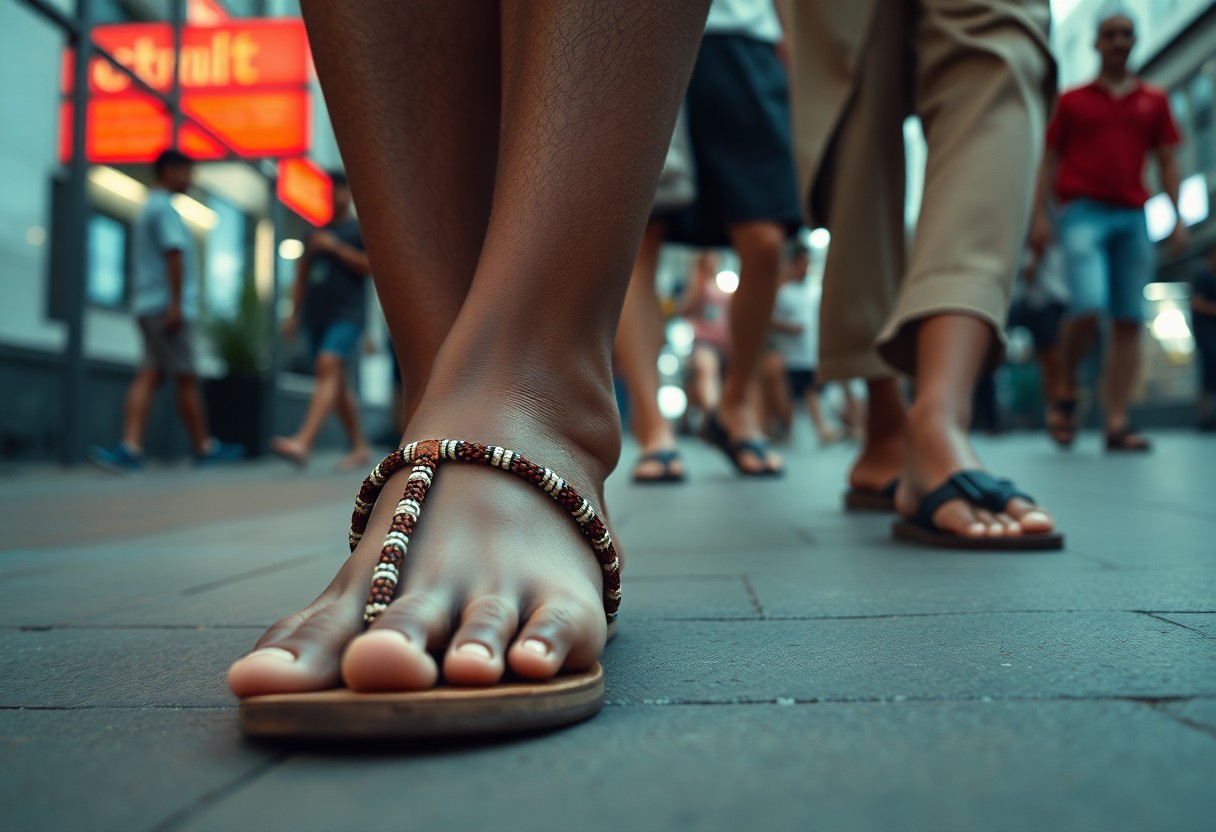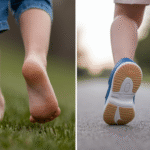
Exploring the fascinating world of barefoot footwear through the lens of cultural anthropology unveils captivating narratives that connect the age-old traditions of Aboriginal cultures with the dynamics of modern urban life. As you delve into this intriguing transformation, you will uncover how cultural beliefs and practices surrounding <a href="https://electroquench.com/xero-shoes-supply-chain-insights-into-minimalist-footwear/">minimalist footwear</a> shape our perceptions of comfort, foster our relationship with nature, and provide avenues for individual expression. Understanding these themes not only enhances your knowledge but also prompts a reconsideration of how your choices in footwear can embody significant cultural meanings and reflect aspects of your personal identity.

Connecting Historical Footwear Practices with Contemporary Innovations
The modern footwear landscape represents a vibrant blend of historical traditions and innovative advancements, fostering an increasing recognition for barefoot footwear. This journey not only pays tribute to traditional indigenous techniques but also integrates them into your contemporary lifestyle seamlessly. By appreciating the significance of these time-honoured practices, you can discover a fascinating fusion of cultural reverence and functional aesthetics in your daily footwear choices, ultimately enriching your personal style while honouring the heritage from which it originates.
Comparing Indigenous Foot Conditioning Practices with Modern Footwear Trends
Across diverse indigenous cultures worldwide, distinctive conditioning techniques have been employed to fortify feet for various terrains. Methods such as walking barefoot on different surfaces have significantly enhanced foot arches and muscle strength in ways that many modern interpretations struggle to replicate. While current minimalist footwear may strive to emulate these benefits, they rarely offer the genuine experience of direct contact with the earth, which is essential for cultivating natural foot strength and flexibility. Engaging in these traditional practices provides a comprehensive understanding of foot health that contemporary designs often overlook, thus enriching your appreciation of both heritage and health.
Exploring the Historical Journey of Military Footwear: From Ancient Caligae to Modern Tactical Boots
The evolution of military footwear is a compelling narrative of adaptation and innovation, tracing its origins from the robust Roman caligae, designed for durability and traction, to today's high-performance tactical boots that seamlessly blend protection, agility, and comfort. A detailed exploration of these transitions reveals a consistent theme: in challenging environments, functionality remains paramount, necessitating equipment that enhances soldiers' stamina and mobility.
The Roman caligae exemplified an advanced response to military demands, crafted from resilient leather with an open-toe design to promote breathability. This ancient footwear featured thick soles that effectively absorbed shock and provided crucial traction, essential for combat scenarios. Fast forward to the present day, and tactical boots have evolved with modern materials such as Kevlar and waterproof membranes, significantly boosting durability and performance. These contemporary designs frequently incorporate padded collars and advanced cushioning systems to minimise injuries during rigorous military operations. Appreciating the heritage of military footwear illuminates how these historical designs have laid the groundwork for today’s innovations, merging tradition, functionality, and cutting-edge technology to meet the evolving needs of modern warriors.

Understanding the Footwear Divide: Urban versus Rural Cultural Perspectives
The differing footwear selections in urban and rural environments reflect notable cultural and practical distinctions. Urban settings often emphasise style and brand identity, whereas rural areas typically prioritise practicality and durability. As barefoot footwear gains popularity, urban residents increasingly adopt its minimalist design as both a fashion statement and a means to achieve perceived health benefits. In contrast, individuals in rural locales may remain sceptical, influenced by traditional values and the practical necessities dictated by their environments.
Recognising the Rising Trend of Barefoot Footwear in Urban Areas
In urban centres, a visible shift towards embracing barefoot footwear is taking place, with adoption rates steadily climbing over the past decade. This trend is driven by several factors, including increased health consciousness, a growing interest in natural movement, and the influence of fitness trends such as yoga and running. Recent studies indicate that around 35% of urban residents have actively sought out barefoot-style shoes, highlighting a cultural shift towards embracing innovative body mechanics and enhancing overall well-being.
Examining Gender Differences in the Adoption of Barefoot Footwear: Who’s at the Forefront?
Gender dynamics significantly influence the acceptance of barefoot footwear, as differing motivations affect the choices of men and women. Women often grapple with heightened societal expectations regarding fashion and aesthetics, which can hinder their willingness to embrace minimalist styles. In contrast, men may be more driven by the performance and health benefits associated with these shoes, resulting in higher adoption rates among the male population.
A deeper analysis of the gendered dimensions of barefoot footwear adoption reveals that societal expectations substantially shape women's decisions. Women frequently navigate an environment where ideals of beauty and fashion overshadow practical health benefits. Research indicates that approximately 45% of men in urban areas are inclined towards barefoot shoes, compared to only 30% of women. Female consumers often wrestle with balancing aesthetic considerations and functionality, making them more cautious when evaluating the design of barefoot footwear against their desire for comfort and support. By empowering women through targeted awareness initiatives and promoting fashionable barefoot options, the willingness to engage with this trend could rise, potentially reshaping urban footwear narratives and fostering inclusivity across genders.

Revolutionary Technologies Shaping the Future of Barefoot Footwear
As the demand for barefoot footwear continues to surge, groundbreaking technologies are poised to transform your experience of comfort and performance. Advances in materials science, along with personalised fitting techniques, promise to enhance functionality while also customising your walking experience, merging time-honoured wisdom with contemporary design philosophies. We are entering a new era where your footwear can be as unique as the journey it accompanies, leading to improved comfort and performance.
Utilising 3D Scanning Technology for an Ideal Fit
The advent of 3D scanning technology is revolutionising the way barefoot footwear is tailored, allowing for a precise fit that conforms to your unique foot shape. Rather than compromising with standard sizes, your shoes can be meticulously crafted to match the contours of your feet, significantly enhancing comfort while reducing the likelihood of injury. The availability of custom-fit options not only elevates your walking experience but also makes barefoot shoes more accessible for individuals with diverse foot shapes and sizes.
Integrating Smart Sensors into Footwear: The Next Evolution in Technology
The integration of smart sensors into barefoot footwear is set to redefine the industry by embedding technology directly into the soles. These pioneering features can monitor various metrics, from distance travelled to foot pressure, providing you with invaluable insights to optimise your walking or running habits. Armed with real-time data, you can make adjustments to your activities that enhance performance and safeguard your well-being.
Imagine having access to real-time analytics as you walk or run. Smart sensors can track your gait, alerting you to any irregularities that may predispose you to injury. Some innovative brands are already developing footwear capable of analysing your foot's impact on different terrains, offering personalised recommendations for style or cushioning adjustments on the fly. This exciting integration combines smart technology with the traditional barefoot philosophy, ensuring you maintain a natural stride while leveraging the latest advancements in wearable technology. The potential to enhance athletic performance, assist in rehabilitation, and improve everyday comfort is limitless, fundamentally transforming how you interact with your environment with each step.
Reflecting on the Journey of Barefoot Footwear Through Time
Your investigation into the cultural anthropology surrounding barefoot footwear unveils a rich narrative woven from the threads of Aboriginal traditions to contemporary urban practices. By embracing the principles of natural movement and fostering a connection to the earth, you gain profound insights into how this footwear philosophy transcends mere fashion, significantly shaping lifestyle choices and community values. As you consider these diverse perspectives, reflect on how your footwear choices can embody and promote a deeper understanding of cultural heritage and adaptability within the modern world.
The Article Cultural Anthropology of Barefoot Footwear: From Aboriginal Traditions to Modern Urban Adoption appeared first on My Shoes Finder
The Article Cultural Anthropology of Barefoot Footwear: Traditions to Today Was Found On https://limitsofstrategy.com
The Article Cultural Anthropology of Barefoot Footwear Through the Ages found first on https://electroquench.com







